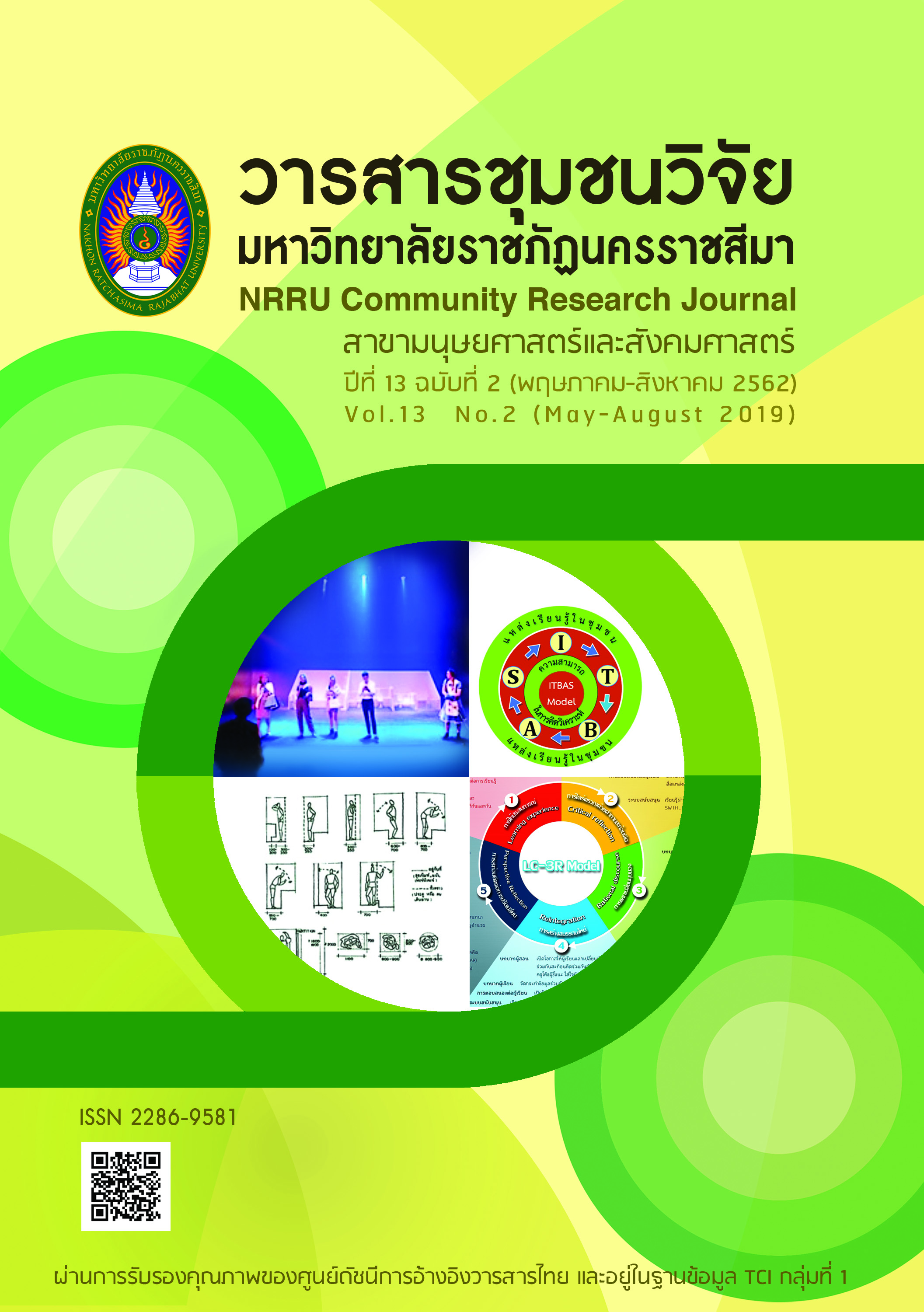มาตรการการจัดการสิ่งแวดล้อม กับการมีส่วนร่วมเพื่อเป็นชุมชนคาร์บอนต่ำ
DOI:
https://doi.org/10.14456/10.14456/nrru-rdi.2019.21คำสำคัญ:
ชุมชนคาร์บอนต่ำ สิ่งแวดล้อม การมีส่วนร่วมบทคัดย่อ
แนวคิดการเป็นชุมชนคาร์บอนต่ำ เป็นแนวคิดเพื่อพัฒนาให้ชุมชนหรือสังคมเกิดความตระหนัก และหันมาสนใจสิ่งแวดล้อมมากขึ้น แต่อย่างไรก็ตาม ก็ยังมีผู้ที่เข้าใจใน ชุมชนสังคมคาร์บอนต่ำ ในปริมาณที่น้อยอยู่ในการศึกษาครั้งนี้จึงเป็นการทบทวนวรรณกรรม ในแนวคิดชุมชนคาร์บอนต่ำ ทั้งในสากลและไทย ในประเด็นของการนิยาม ความหมาย และ กลยุทธ์สู่การส่งเสริมให้เกิดการรักษ์สิ่งแวดล้อม ผ่านมาตรการการจัดการสิ่งแวดล้อม รวมถึงการสังเคราะห์จากงานวิจัยและงานบริการวิชาการที่เกี่ยวเนื่อง โดยมีวัตถุประสงค์ คือ 1) ให้เข้าใจในแนวคิดชุมชนคาร์บอนต่ำด้วยการปรับเปลี่ยนพฤติกรรม 2) เสนอแนวทางการเป็นชุมชนคาร์บอนต่ำด้วยมาตรการการส่งเสริมต่อจิตใจ สร้างความตระหนัก ซึ่งการสร้างความเข้าใจต่อชุมชนถึงเรื่อง ชุมชนคาร์บอนต่ำ นั้นมีความสำคัญ เพราะชุมชนจะเป็นหน่วยการขับเคลื่อนในการปรับเปลี่ยนพฤติกรรมเพื่อส่งเสริมต่อการเป็นชุมชนคาร์บอนต่ำ ด้านการสร้างแรงจูงใจ และปลูกจิตสำนึก ที่ควรส่งเสริมในลำดับแรก ก่อนการส่งเสริมด้านเครื่องมือทางเศรษฐศาสตร์และมาตรการด้านกฎเกณฑ์ ข้อบังคับ เนื่องจาก มาตรการด้านการสร้างแรงจูงใจ เป็นมาตรการที่เกิดขึ้นจากความสมัครใจ ไม่มีการบังคับ และหากได้มีการสนับสนุนพัฒนาจนเป็นนโยบายระดับประเทศ ที่ขับเคลื่อนหลักในมาตรการการจัดการสิ่งแวดล้อมแล้ว ก็จะยิ่งส่งเสริมให้ชุมชนสังคมคาร์บอนต่ำ เป็นชุมชนแบบยั่งยืนอย่างแท้จริง
References
Amin, A.T.M., N. (2005). The Informal Sector’s Role in Urban Environmental Management. International Review for Environmental Strategies, 5(2), 511-530.
Burns, P., & Riechmann, C. (2004). Regulatory instruments and investment behavior. Utilities Policy. 12(2004), 211-219. Retrieved March 1, 2019, from https://ac.els-cdn.com/S0957 178704000712/1-s2.0-S0957178704000712-main.pdf?_tid=5e8644f1-6525-4aa1-8d70-684 ecc20cd05&acdnat= 1551406945_b11f7dced92fefc7c9b403f3726ab289.
Caulier-Grice, J. (2010). Social innovation exchange. Retrieved October 1, 2018, from https:// socialinnovator.info/blog/social-innovator/what-social-innovation.
Chanjirawuttikul, N. (2012). Leading the Way to Low Carbon Society: A Paradigm and Driving. TRF Policy Brief, 3(20). (In Thai)
Chavez, C. A., Vilena, M. G., & Stranlund, J. K. (2010). The choice of policy instruments to control pollution under costly enforcement and incomplete information. Journal of Applied Economics, 12(2), 207-227. Retrieved March 1, 2019, from https://www.sciencedirect .com/science/article/pii/S1514032609600131#!
Greyson, J. (2007). An economic instrument for zero waste, economic growth and sustainability. Journal of Cleaner Production, 15(13-14), 1382-1390. Retrieved March 1, 2019, from https://www.sciencedirect.com/science/article/pii/S0959652606002733
Harring, N., & Ronnerstrand, B. (2016). Government effectiveness, regulatory compliance and public preference for marine policy instruments. An experimental approach. Marine Policy, 71 (September 2016), 106-110. Retrieved March 1, 2019, from https://www. sciencedirect.com/ science/article/pii/S0308597X16303128#!
Janjirawuttikul, N. (2017). Low carbon society: a paradigm for development and driving. Retrieved October 1, 2018, from https://prp.trf.or.th/trf-policy-brief/สู่สังคมคาร์บอนต่ำ-กระ/ (In Thai)
Leknoi, U. (2017). Suburban community to green community driven guideline: Low Carbon Community. Journal of MCU Peace Studies, 5(2), 56-74. (In Thai)
_______. (2018). Guideline for building community engagement towards low carbon community in Bangkok Metropolitan. Journal of Environmental Management, 14(2), 78-95. Retrieved October 1, 2018, from https://www.tci-thaijo.org/index.php/JEM/article/view/106394/117119 (In Thai)
Matichon. (2016). The government and private sector join forces to bring Thailand into a "low carbon" society. Retrieved October 1, 2018, from https://www.matichon.co.th/news/6418 (In Thai)
Mingsheng, L., & Li, Y. (2012). Discussion on the Mode of China’s Low-carbon Society and Construction Routes. Chinese Journal of Population Resources and Environment, 10(1), 13-18.
Minh, N. T. B., & Amin, A.T.M., N. (2002). The role of foreign direct investment in urban environmental management: Some evidence from Hanoi, Vietnam. Environment, Development and Sustainability, 4(4), 279–297.
Nahman, A., & Godfrey, L. (2018). Economic instruments for solid waste management in South Africa: Opportunities and constraints. Resources, Conservation and Recycling, 54(8), 521-531. Retrieved March 1, 2019, from https://www.sciencedirect.com/science/article/pii/S092134490900233X#!
Niles, J. O., Brown, S., Pretty, J., Ball, A. S., & Fay, J. (2002). Potential carbon mitigation and income in developing countries from changes in use and management of agricultural and forest lands. Philosophical Transactions of the Royal Society of London A: Mathematical, Physical and Engineering Sciences, 360(1797), 1621-1639.
Permana, A. S., & Aziz, N.A. (2016). Land Use, Urban Mobility and Environment Nexus: Evidence from a Developing City. Universiti Teknologi Malaysia, ISBN: 978-983-52-1158-4.
Permana, A. S., Perera, R., Aziz, N. A., & Ho, C. S. (2015). Creating the Synergy of Land Use, Transport, Energy and Environment Elements towards Climate Change Co-benefits. International Journal of Built Environment and Sustainability, 2(1), 17-28. DOI: https://dx.doi.org/10.11113/ijbes.v2.n1.53
Potipituk, C. (2015). Low-Carbon Society Learning by Infographic Media : Case Study of Faculty of Architecture and Design, Rajamangala University of Technology Rattanakosin, Salaya. Retrieved October 28, 2018, from https://www.youtube.com/watch?v=gBl6yrWNE-E (In Thai)
Potipituk, C., & Permana, A. S. (2014). Barriers to the Implementation of Environmental Management Measures in the Operation of Shop House Enterprises in Bangkok Metropolitan Area. International Journal of Built Environment and Sustainability, 1(1),1-8. DOI:https://dx. doi.org/10.11113/ijbes.v1.n1.2 (In Thai)
Potipituk, C., Kaosal, S., Boonphoapichart, S, Thongmee, S.,Siriin, P. , Saisakorn, A. , Piyavajee, A, & Srisombat, C. (2018). Sustainable Communities: Basic Environmental Management for Residential Buildings. In 14th Asian Urbanization Conference “Sustainable Development Goals in Asia” (January 11-13, 2018). (In Thai)
Rathrung, C. (2012). Low-Carbon Society. Retrieved February 28, 2019, from https://low-carbon-society.blogspot.com/2012/02/blog-post.html (In Thai)
Saravia, M., Devenish, C., De Bièvre, B., & Peralvo, M. (2013). CONDESAN: Better knowledge, better decisions—supporting sustainable Andean mountains development. Mountain Research and Development, 33(3), 339-342.
Skea, J., & Nishioka, S. (2008). Policies and practices for a low-carbon society. Climate Policy 8. S5-S16.
Stern, J. (2014). The British utility regulation model: Its recent history and future prospects. Utilities Policy, 31 (December 2014), 162-172. Retrieved March 1, 2019, from https://www. sciencedirect.com/science/article/pii/S0957178714000666
Therdyothin, A. (2015). Holds 6 Energy Conservation Measures in Building Sector Following NAMAs Greenhouse Gas Emissions Reduction. Retrieved October 28, 2018, from https://www.manager.co.th/iBizchannel/viewNews.aspx?NewsID=9580000084651 (In Thai)
Yuttitham, M. (2009). Thailand Opportunity for CO2 Reduction through Carbon Credit in Sugarcane Production. Retrieved October 28, 2018, from www.myfirstbrain.com/student_view. aspx?id=75763.https://www.tei.or.th/news-environment/091228-1-01.pdf (In Thai)



